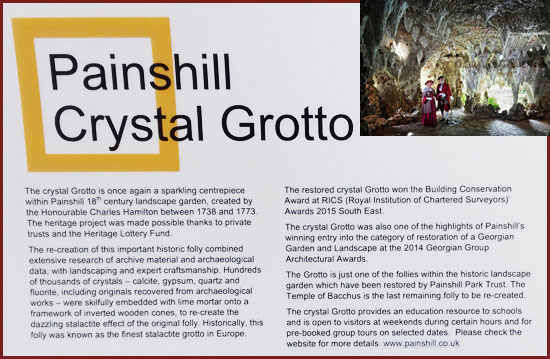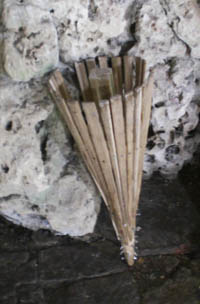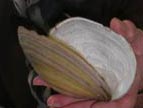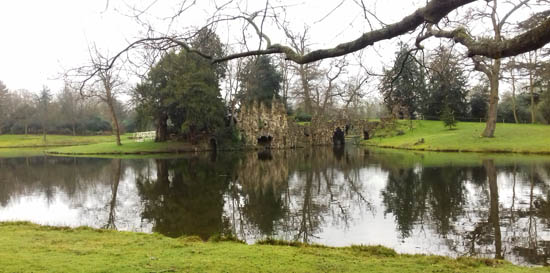
HOME





HOME
|

|

|

|

|
|
P R O F I L E |
||||
|
  Painshill or Cobham Park
Painshill or Cobham ParkGrotto with sacred spring Cobham Surrey United Kingdom KT11 1JE Telephone: 01932 868113 When Arthur Young visited Cobham in 1767, he first recorded in his diary that Mr Hamilton's ornamental park at Cobham was "exceedingly well worth your attention. . . . .From thence we wind through a fresh walk, near another part of the water, cross a bridge, formed to appearance of rocks and fossils; and turning down, to the right, find that this bridge is the covering for a most beautiful grotto, as well as the water; for immediately under it, is a large incrustation of fossils; and spar hanging every where like icicles from the ceiling, a most pleasing effect. On each side the water is a small path, parted from the stream by marine fossils; nothing can have a more elegant effect than the ceiling of this grotto, (in which is stuck, with great taste, a profusion of spar) hanging over the water, as if of a kindred, but congealed nature. From this grotto the walk leads to . . . . . " 
Today grottoes are being extensively restored and one such restoration well worth visiting is Painshill, at Cobham in Surrey. Built in 1760-70, it adjoins two islands in the extensive man-made lake, alongside which flows the River Mole. At the time of construction the estate was in the hands of the Hon. Charles Hamilton, 9th son of the 6th Earl of Abercorn. His efforts produced a garden estate that was seen as England's most elegant 18th century natural landscape design. The grotto was one of many features constructed at the time and was considered the finest ever built. Two hundred years later, by the 1970s the crystal grotto was derelict and the roof had collapsed. A Trust was formed in 1981 to restore the park and the grotto restoration was completed in 2013 together with the restoration of many other landscape features at Painshill. Heritage Lottery Funding enabled the access as well as the grotto itself to be returned to good order. Inside visitors now find a plethora of features which typify 18th century grotto design. The mystic spring is of particular interest and this has a water cascade flowing to a series of pools in the main chamber. The lower walls of the grotto are lined with dark clinker stone and the roof with stalactites created from gypsum, calcite, quartz and fluorite. This results in an amazing underground experience for visitors exploring the mysterious passages where peep holes reveal spectacular views across the lake. Outside natural oolitic limestone creates the impression of a rocky outcrop concealing its hidden secrets. When restoring the grotto, traditional methods were used for reinstatement of the various features. In the case of the stalactites, a wooden frame provided the foundation for the decoration. 
Since the restoration, a bust of Homer which used to be one of a number of sculptures here, has been located in the main chamber. This evokes the adventures of the Iliad, and grottoes of the ancient world. The shell of the freshwater pearl mussel, a protected species, is found in the lake that surrounds the grotto. This example came to light during the floods of January 2014. This bivalve is capable of making high quality pearls and can live for up to 130 years. (identified by the staff at Painshill)  Was the pearl mussel a means whereby Hamilton extended the idea of a heavenly cave into the lake itself? Such an innovation would have put him ahead of the competition in grotto design. Was the pearl mussel a means whereby Hamilton extended the idea of a heavenly cave into the lake itself? Such an innovation would have put him ahead of the competition in grotto design.Illustrations: 1-8 are sequencing at the top of this web page. 1. Modern day visitors enter the grotto from the island. 2. Glimpse from the grotto. 3. Gothic Temple and the five arch bridge in the distance. 4. The ruined Abbey on the site of the old brickworks. 5. The grotto entrance in the 1950s. 6. Stalactites formed on wooden frames within the grotto. 7. The sacred spring feature in the grotto fed by a cascading waterfall, when the pump is operational that is. 8. The Gothic Tower. 
Picture above - Viewed from the lake the grotto creates an air of wonderment, apprehension and inquisitiveness. A more detailed, larger picture of the interior of Painshill grotto is on the "County Search" page of Grotto.Directory web site. Website: Click Here ADDITIONAL INFORMATION   
GREAT BRITISH GROTTO GRADING
CONSTRAINTS Open set times only FACILITIES Access by Road, Access on Foot, Entry Fee, Grotto - just one, Restaurant/Food, Retail Souvenir Shop, Toilets, Tourism Information LANDSCAPE Country town/village REGION England - Southern THE FEATURES PRESENT +A created provenance that links it to ancient mythology or legend, +Cared for and maintained in good condition, +Crystals and/or minerals, either natural or simulated, +Dark and mysterious chambers and cave like spaces, +External rock structures, either real or simulated, +Fossils and/or shells incorporated into the decor, +Internal stonework that is natural, recycled or simulated to give a subterranean decor, +Sacred spring or integral water feature, +Stunning setting and location, +Viewing points from within to an intriguing landscape outside, GRADED TEN Top Score WOW! |
||||
|